David's Astronomy Pages
Notes - Session 937 (2021-11-24)
Notes
(S936)
Notes
Main
Home
Page
Notes
(S938)
David's Astronomy Pages
|
Notes (S936) |
Notes Main |
Home Page |
Notes (S938) |
|
|
Session Aims & Highlights |
| - Observing Result - Night Summary Plot - Session Event Log |
|
|
|
Operational Issues |
| - Critical Issues (0),
Major Issues (0),
Minor Issues (2),
Small Defects (2), Continuous Improvement (5) |
|
 |
Images from 2021-11-24 >> [ Local Files >> ] |
|
|
Guiding Issues (2021-11-24) |
|
|
Investigation - Excessive Dec movements during Guiding (2021-11-24) (Backlash / Retrograde Motion ? ) |
|
|
Notes on Reducing/Eliminating Retrograde Dec Motion |
Main aims
Equipment & Software
Highlights
Summary Plots & Logs
| Observing Plan | ||||||||||||||||||||||||||||||||||||||||||||||||||||||||||||||||||||||||||||||||||||||||||||||||||||||||||||||||||||||||||||||||||||||||||||||||||||||||||||||||||||||||||||||||||||||||||||||||||||||||||||||||||||||||||||||||||||||||||||||||||||||||||||||||||||||||||||||||||||||||||||||||||||||||||||||||||||||||||||||||||||||||||||||||||||||||||||||||||||||||||||||||||||||||||||||||||||||||||||||||||||||||||||||||||||||||||||||||||||||||||||||||||||||||||||||||||||||||||||||||||||||||||||||||||||||||||||||||||||||||||||||||||||||||||||||||||||||||||||
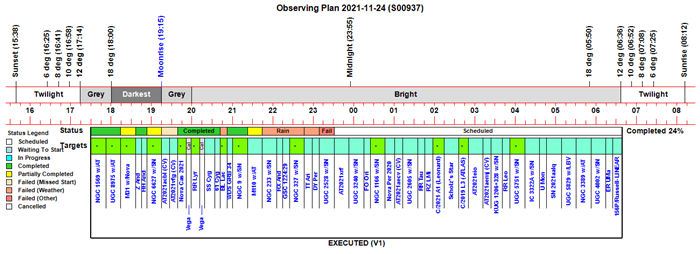 |
||||||||||||||||||||||||||||||||||||||||||||||||||||||||||||||||||||||||||||||||||||||||||||||||||||||||||||||||||||||||||||||||||||||||||||||||||||||||||||||||||||||||||||||||||||||||||||||||||||||||||||||||||||||||||||||||||||||||||||||||||||||||||||||||||||||||||||||||||||||||||||||||||||||||||||||||||||||||||||||||||||||||||||||||||||||||||||||||||||||||||||||||||||||||||||||||||||||||||||||||||||||||||||||||||||||||||||||||||||||||||||||||||||||||||||||||||||||||||||||||||||||||||||||||||||||||||||||||||||||||||||||||||||||||||||||||||||||||||||
|
Observing Result |
||||||||||||||||||||||||||||||||||||||||||||||||||||||||||||||||||||||||||||||||||||||||||||||||||||||||||||||||||||||||||||||||||||||||||||||||||||||||||||||||||||||||||||||||||||||||||||||||||||||||||||||||||||||||||||||||||||||||||||||||||||||||||||||||||||||||||||||||||||||||||||||||||||||||||||||||||||||||||||||||||||||||||||||||||||||||||||||||||||||||||||||||||||||||||||||||||||||||||||||||||||||||||||||||||||||||||||||||||||||||||||||||||||||||||||||||||||||||||||||||||||||||||||||||||||||||||||||||||||||||||||||||||||||||||||||||||||||||||||
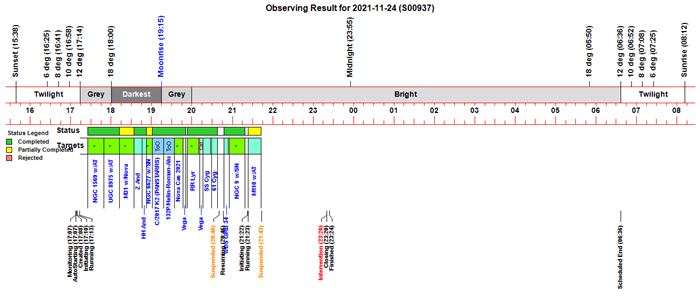 |
||||||||||||||||||||||||||||||||||||||||||||||||||||||||||||||||||||||||||||||||||||||||||||||||||||||||||||||||||||||||||||||||||||||||||||||||||||||||||||||||||||||||||||||||||||||||||||||||||||||||||||||||||||||||||||||||||||||||||||||||||||||||||||||||||||||||||||||||||||||||||||||||||||||||||||||||||||||||||||||||||||||||||||||||||||||||||||||||||||||||||||||||||||||||||||||||||||||||||||||||||||||||||||||||||||||||||||||||||||||||||||||||||||||||||||||||||||||||||||||||||||||||||||||||||||||||||||||||||||||||||||||||||||||||||||||||||||||||||||
| Dome & Scope Slewing Performance | ||||||||||||||||||||||||||||||||||||||||||||||||||||||||||||||||||||||||||||||||||||||||||||||||||||||||||||||||||||||||||||||||||||||||||||||||||||||||||||||||||||||||||||||||||||||||||||||||||||||||||||||||||||||||||||||||||||||||||||||||||||||||||||||||||||||||||||||||||||||||||||||||||||||||||||||||||||||||||||||||||||||||||||||||||||||||||||||||||||||||||||||||||||||||||||||||||||||||||||||||||||||||||||||||||||||||||||||||||||||||||||||||||||||||||||||||||||||||||||||||||||||||||||||||||||||||||||||||||||||||||||||||||||||||||||||||||||||||||||
 |
||||||||||||||||||||||||||||||||||||||||||||||||||||||||||||||||||||||||||||||||||||||||||||||||||||||||||||||||||||||||||||||||||||||||||||||||||||||||||||||||||||||||||||||||||||||||||||||||||||||||||||||||||||||||||||||||||||||||||||||||||||||||||||||||||||||||||||||||||||||||||||||||||||||||||||||||||||||||||||||||||||||||||||||||||||||||||||||||||||||||||||||||||||||||||||||||||||||||||||||||||||||||||||||||||||||||||||||||||||||||||||||||||||||||||||||||||||||||||||||||||||||||||||||||||||||||||||||||||||||||||||||||||||||||||||||||||||||||||||
|
Slew/Centering Performance Good centering performance (Dec Anti-Backlash setting in Scope = 90%) |
||||||||||||||||||||||||||||||||||||||||||||||||||||||||||||||||||||||||||||||||||||||||||||||||||||||||||||||||||||||||||||||||||||||||||||||||||||||||||||||||||||||||||||||||||||||||||||||||||||||||||||||||||||||||||||||||||||||||||||||||||||||||||||||||||||||||||||||||||||||||||||||||||||||||||||||||||||||||||||||||||||||||||||||||||||||||||||||||||||||||||||||||||||||||||||||||||||||||||||||||||||||||||||||||||||||||||||||||||||||||||||||||||||||||||||||||||||||||||||||||||||||||||||||||||||||||||||||||||||||||||||||||||||||||||||||||||||||||||||
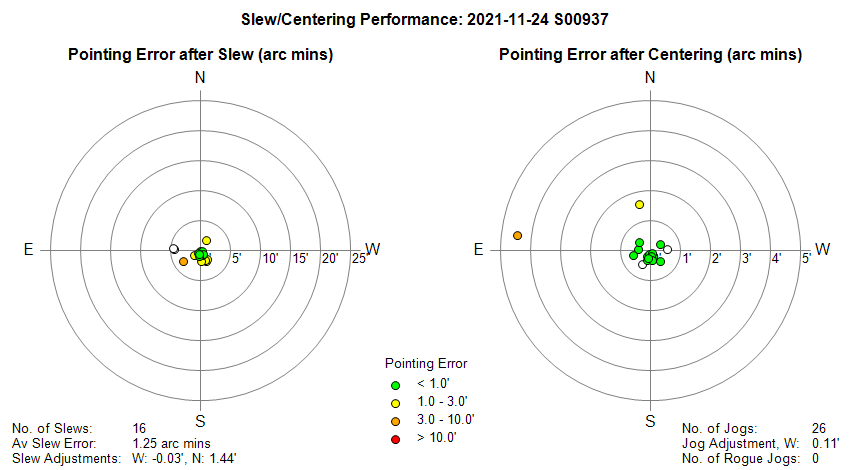 |
||||||||||||||||||||||||||||||||||||||||||||||||||||||||||||||||||||||||||||||||||||||||||||||||||||||||||||||||||||||||||||||||||||||||||||||||||||||||||||||||||||||||||||||||||||||||||||||||||||||||||||||||||||||||||||||||||||||||||||||||||||||||||||||||||||||||||||||||||||||||||||||||||||||||||||||||||||||||||||||||||||||||||||||||||||||||||||||||||||||||||||||||||||||||||||||||||||||||||||||||||||||||||||||||||||||||||||||||||||||||||||||||||||||||||||||||||||||||||||||||||||||||||||||||||||||||||||||||||||||||||||||||||||||||||||||||||||||||||||
|
Guiding Performance Reasons for poor Dec guiding :
|
||||||||||||||||||||||||||||||||||||||||||||||||||||||||||||||||||||||||||||||||||||||||||||||||||||||||||||||||||||||||||||||||||||||||||||||||||||||||||||||||||||||||||||||||||||||||||||||||||||||||||||||||||||||||||||||||||||||||||||||||||||||||||||||||||||||||||||||||||||||||||||||||||||||||||||||||||||||||||||||||||||||||||||||||||||||||||||||||||||||||||||||||||||||||||||||||||||||||||||||||||||||||||||||||||||||||||||||||||||||||||||||||||||||||||||||||||||||||||||||||||||||||||||||||||||||||||||||||||||||||||||||||||||||||||||||||||||||||||||
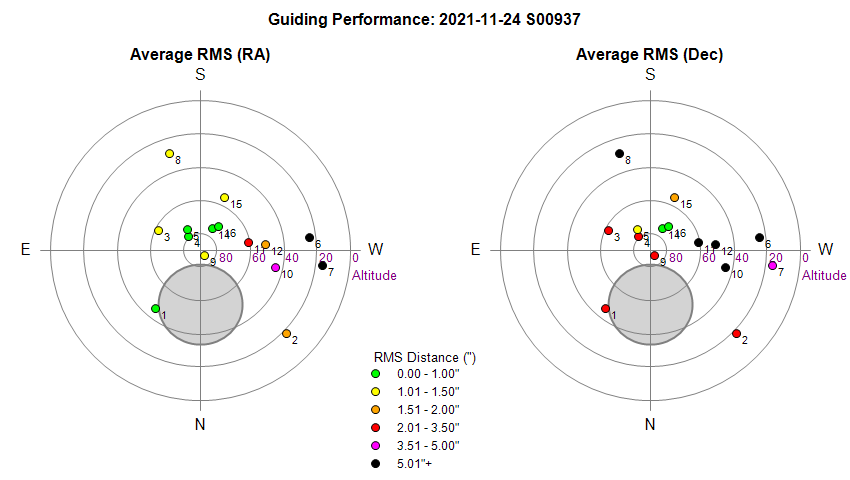 |
||||||||||||||||||||||||||||||||||||||||||||||||||||||||||||||||||||||||||||||||||||||||||||||||||||||||||||||||||||||||||||||||||||||||||||||||||||||||||||||||||||||||||||||||||||||||||||||||||||||||||||||||||||||||||||||||||||||||||||||||||||||||||||||||||||||||||||||||||||||||||||||||||||||||||||||||||||||||||||||||||||||||||||||||||||||||||||||||||||||||||||||||||||||||||||||||||||||||||||||||||||||||||||||||||||||||||||||||||||||||||||||||||||||||||||||||||||||||||||||||||||||||||||||||||||||||||||||||||||||||||||||||||||||||||||||||||||||||||||
 |
||||||||||||||||||||||||||||||||||||||||||||||||||||||||||||||||||||||||||||||||||||||||||||||||||||||||||||||||||||||||||||||||||||||||||||||||||||||||||||||||||||||||||||||||||||||||||||||||||||||||||||||||||||||||||||||||||||||||||||||||||||||||||||||||||||||||||||||||||||||||||||||||||||||||||||||||||||||||||||||||||||||||||||||||||||||||||||||||||||||||||||||||||||||||||||||||||||||||||||||||||||||||||||||||||||||||||||||||||||||||||||||||||||||||||||||||||||||||||||||||||||||||||||||||||||||||||||||||||||||||||||||||||||||||||||||||||||||||||||
| Sky Conditions (Locate Frames) | ||||||||||||||||||||||||||||||||||||||||||||||||||||||||||||||||||||||||||||||||||||||||||||||||||||||||||||||||||||||||||||||||||||||||||||||||||||||||||||||||||||||||||||||||||||||||||||||||||||||||||||||||||||||||||||||||||||||||||||||||||||||||||||||||||||||||||||||||||||||||||||||||||||||||||||||||||||||||||||||||||||||||||||||||||||||||||||||||||||||||||||||||||||||||||||||||||||||||||||||||||||||||||||||||||||||||||||||||||||||||||||||||||||||||||||||||||||||||||||||||||||||||||||||||||||||||||||||||||||||||||||||||||||||||||||||||||||||||||||
 |
||||||||||||||||||||||||||||||||||||||||||||||||||||||||||||||||||||||||||||||||||||||||||||||||||||||||||||||||||||||||||||||||||||||||||||||||||||||||||||||||||||||||||||||||||||||||||||||||||||||||||||||||||||||||||||||||||||||||||||||||||||||||||||||||||||||||||||||||||||||||||||||||||||||||||||||||||||||||||||||||||||||||||||||||||||||||||||||||||||||||||||||||||||||||||||||||||||||||||||||||||||||||||||||||||||||||||||||||||||||||||||||||||||||||||||||||||||||||||||||||||||||||||||||||||||||||||||||||||||||||||||||||||||||||||||||||||||||||||||
|
Night Sky Summary Plot Top axis: Sky Brightness at Zenith (in ADU/s) Lefthand axis: Local Time (hh LT). Righthand axis: Sun Altitude (degs) |
||||||||||||||||||||||||||||||||||||||||||||||||||||||||||||||||||||||||||||||||||||||||||||||||||||||||||||||||||||||||||||||||||||||||||||||||||||||||||||||||||||||||||||||||||||||||||||||||||||||||||||||||||||||||||||||||||||||||||||||||||||||||||||||||||||||||||||||||||||||||||||||||||||||||||||||||||||||||||||||||||||||||||||||||||||||||||||||||||||||||||||||||||||||||||||||||||||||||||||||||||||||||||||||||||||||||||||||||||||||||||||||||||||||||||||||||||||||||||||||||||||||||||||||||||||||||||||||||||||||||||||||||||||||||||||||||||||||||||||
 |
||||||||||||||||||||||||||||||||||||||||||||||||||||||||||||||||||||||||||||||||||||||||||||||||||||||||||||||||||||||||||||||||||||||||||||||||||||||||||||||||||||||||||||||||||||||||||||||||||||||||||||||||||||||||||||||||||||||||||||||||||||||||||||||||||||||||||||||||||||||||||||||||||||||||||||||||||||||||||||||||||||||||||||||||||||||||||||||||||||||||||||||||||||||||||||||||||||||||||||||||||||||||||||||||||||||||||||||||||||||||||||||||||||||||||||||||||||||||||||||||||||||||||||||||||||||||||||||||||||||||||||||||||||||||||||||||||||||||||||
|
Actual Weather vs Pre-Session Weather Forecast |
||||||||||||||||||||||||||||||||||||||||||||||||||||||||||||||||||||||||||||||||||||||||||||||||||||||||||||||||||||||||||||||||||||||||||||||||||||||||||||||||||||||||||||||||||||||||||||||||||||||||||||||||||||||||||||||||||||||||||||||||||||||||||||||||||||||||||||||||||||||||||||||||||||||||||||||||||||||||||||||||||||||||||||||||||||||||||||||||||||||||||||||||||||||||||||||||||||||||||||||||||||||||||||||||||||||||||||||||||||||||||||||||||||||||||||||||||||||||||||||||||||||||||||||||||||||||||||||||||||||||||||||||||||||||||||||||||||||||||||
 |
||||||||||||||||||||||||||||||||||||||||||||||||||||||||||||||||||||||||||||||||||||||||||||||||||||||||||||||||||||||||||||||||||||||||||||||||||||||||||||||||||||||||||||||||||||||||||||||||||||||||||||||||||||||||||||||||||||||||||||||||||||||||||||||||||||||||||||||||||||||||||||||||||||||||||||||||||||||||||||||||||||||||||||||||||||||||||||||||||||||||||||||||||||||||||||||||||||||||||||||||||||||||||||||||||||||||||||||||||||||||||||||||||||||||||||||||||||||||||||||||||||||||||||||||||||||||||||||||||||||||||||||||||||||||||||||||||||||||||||
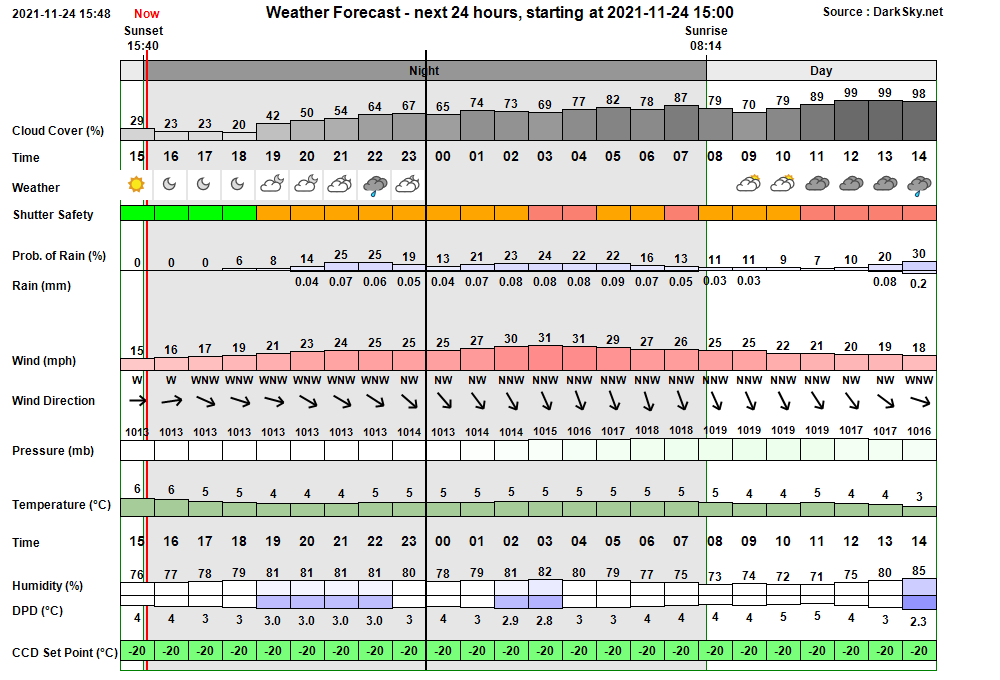 |
||||||||||||||||||||||||||||||||||||||||||||||||||||||||||||||||||||||||||||||||||||||||||||||||||||||||||||||||||||||||||||||||||||||||||||||||||||||||||||||||||||||||||||||||||||||||||||||||||||||||||||||||||||||||||||||||||||||||||||||||||||||||||||||||||||||||||||||||||||||||||||||||||||||||||||||||||||||||||||||||||||||||||||||||||||||||||||||||||||||||||||||||||||||||||||||||||||||||||||||||||||||||||||||||||||||||||||||||||||||||||||||||||||||||||||||||||||||||||||||||||||||||||||||||||||||||||||||||||||||||||||||||||||||||||||||||||||||||||||
| Session Event Log | ||||||||||||||||||||||||||||||||||||||||||||||||||||||||||||||||||||||||||||||||||||||||||||||||||||||||||||||||||||||||||||||||||||||||||||||||||||||||||||||||||||||||||||||||||||||||||||||||||||||||||||||||||||||||||||||||||||||||||||||||||||||||||||||||||||||||||||||||||||||||||||||||||||||||||||||||||||||||||||||||||||||||||||||||||||||||||||||||||||||||||||||||||||||||||||||||||||||||||||||||||||||||||||||||||||||||||||||||||||||||||||||||||||||||||||||||||||||||||||||||||||||||||||||||||||||||||||||||||||||||||||||||||||||||||||||||||||||||||||
|
||||||||||||||||||||||||||||||||||||||||||||||||||||||||||||||||||||||||||||||||||||||||||||||||||||||||||||||||||||||||||||||||||||||||||||||||||||||||||||||||||||||||||||||||||||||||||||||||||||||||||||||||||||||||||||||||||||||||||||||||||||||||||||||||||||||||||||||||||||||||||||||||||||||||||||||||||||||||||||||||||||||||||||||||||||||||||||||||||||||||||||||||||||||||||||||||||||||||||||||||||||||||||||||||||||||||||||||||||||||||||||||||||||||||||||||||||||||||||||||||||||||||||||||||||||||||||||||||||||||||||||||||||||||||||||||||||||||||||||
| Session Alerts | ||||||||||||||||||||||||||||||||||||||||||||||||||||||||||||||||||||||||||||||||||||||||||||||||||||||||||||||||||||||||||||||||||||||||||||||||||||||||||||||||||||||||||||||||||||||||||||||||||||||||||||||||||||||||||||||||||||||||||||||||||||||||||||||||||||||||||||||||||||||||||||||||||||||||||||||||||||||||||||||||||||||||||||||||||||||||||||||||||||||||||||||||||||||||||||||||||||||||||||||||||||||||||||||||||||||||||||||||||||||||||||||||||||||||||||||||||||||||||||||||||||||||||||||||||||||||||||||||||||||||||||||||||||||||||||||||||||||||||||
|
Back to Top
Back to Top
Guiding Issues
A number of guiding issues occured during
the session. These are listed below in order of significance (with the
most significant listed first)
Examples
The various guiding issues are illustrated by the following examples.
( Red Line = Dec, Blue Line = Ra, Black line = Star SNR, Green Line =
Focus Changes, Orange Line = Star Lost Events)
1) Incorrect initial guide direction & non-effective Dec guiding (Guide Run 3, M31)
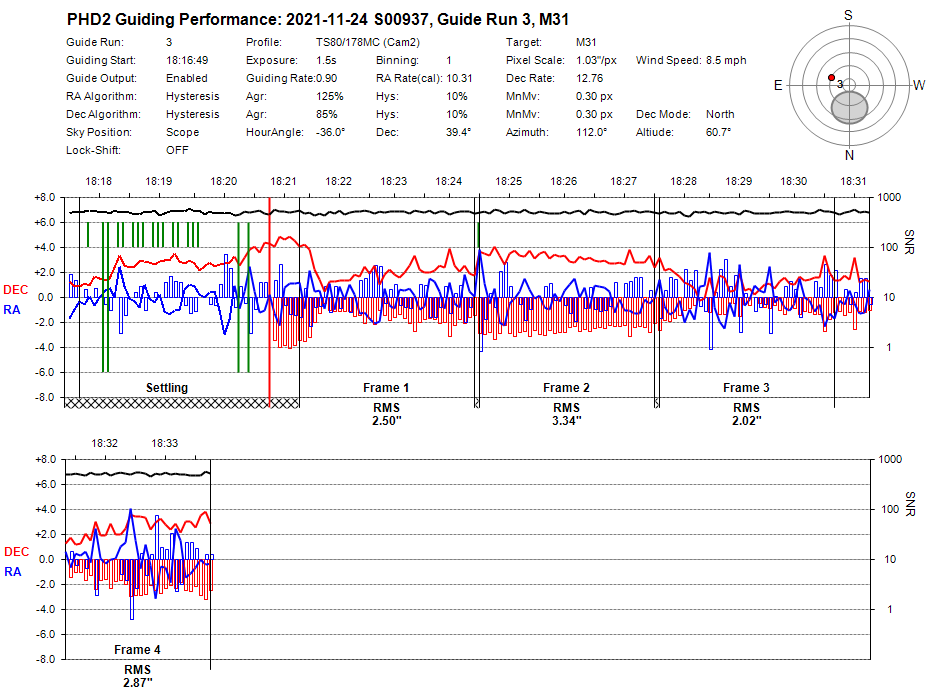
- North Guide Mode auto-selected instead of the required South Mode (fixed
in AstroMain 3.47.3)
- Drift 18:18:00 to 18:20:30 (Dec Mode should have
been changed during this settling phase)
- Dec Mode changed at 18:20:40.
Guide error gradually reduced.
- Drift 18:22 to 18:26. South Guiding not
effective at holding or correcting star drift.
- Drift 18:29:30 to
18:33:30. South Guiding not effective at holding or correcting drift (is
this a telescope balance issue ?)
2) Incorrect initial guide direction & non-effective Dec guiding (Guide Run 4, Z And)
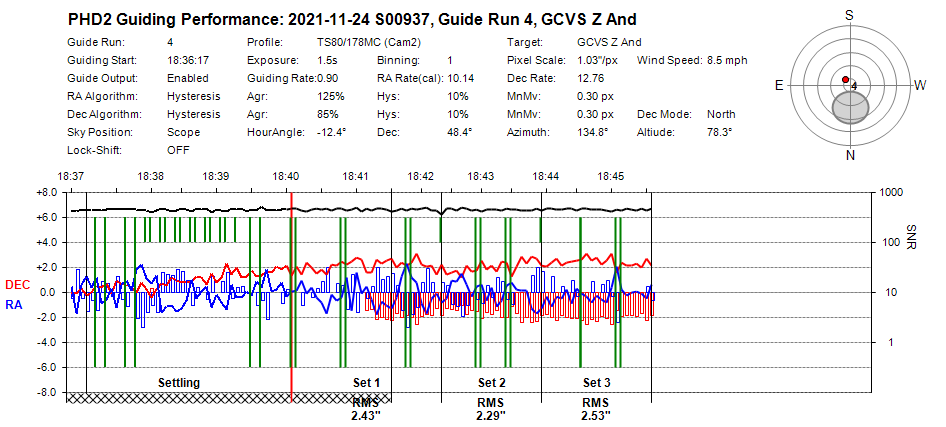
- North Guide Mode auto-selected instead of the required South Mode (fixed
in AstroMain 3.47.3)
- Drift 18:38:00 to 18:41 (Dec Mode should have been
changed earlier ?)
- Dec Mode changed to South at 18:41 (anti-backlash
either not applied by scope or not an issue)
- Dec Error c. 2" from
18:41:00 to 18:45:30. Guiding stops further drift but doesn't correct the 2"
error (is this a telescope balance issue)
3) Incorrect initial guide direction, excessive antibacklash (Guide Run 8, 132P/Helin-Roman-Alu)
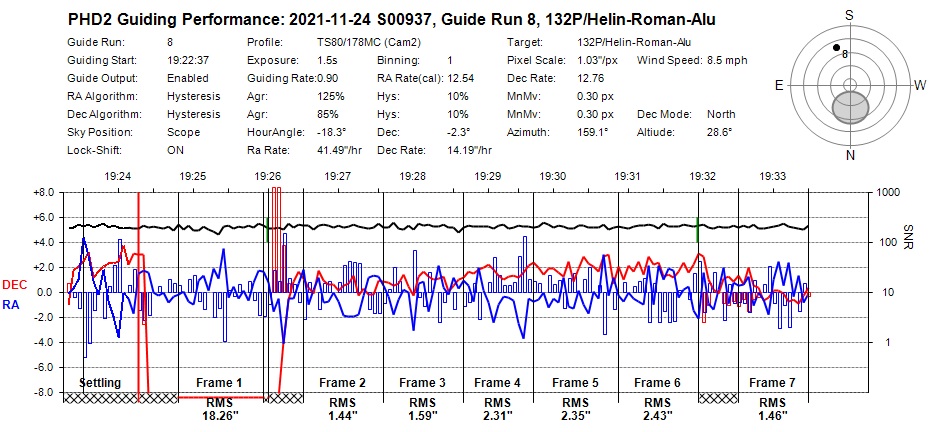
- North Guide Mode auto-selected at start instead of the required South
Mode (fixed in AstroMain 3.47.3)
- Dec Guide Mode changed to South at
19:24:27. Single Dec guide step moves scope from +3" to -19" .
Probably due to excessive anti-backlash compensation by scop
(fix attempted with reduction in antibacklash setting from 100% to 90%)
- Dec Guide Mode changed to North at 19:26. Guide
error quickly corrected (no issue with anti-backlash overcompensation)
- Dec gradually drifting (17:29 to 17:32). Guide mode should
have been changed to South at earlier point ?
- Dec Guide Mode
changed to South at 19:32. Guide error quickly corrected (no
issue with anti-backlash overcompensation)
4) Incorrect initial guide direction & non-effective Dec guiding (Guide Run 15, NGC 9)

- South Guide Mode auto-selected at start instead of the required North
Mode (fixed in AstroMain 3.47.3)
- Dec Jump at 20:59:10 (possibly
related to focuser change)
- Dec Guide Mode changed to North at
21:02:40. Guide error gradually corrected (no issue with
anti-backlash overcompensation)
- Guiding ok 21:04 to 21:08 despite
passing cloud
- Lost star events at 21:08:20 & 21:09:30 effects
guiding (cloud)
- Clear sky but Dec gradually drifting (21:10 to
21:19). Northward Dec guiding not effective at holding/correcting
position (is this a telescope balance issue ?)
5) Impossible guiding due to wind conditions (Guide Run 7, C/2017 K2 (PANSTARRS) )
.png)
- Wind / Cloud - Guiding impossible under these conditions
6) Unexpected jumps in dec, unusual spikey movements during uni-directional guiding (Guide Run 1, NGC 1569)

- North Guide Mode auto-selected instead of the required South Mode (fixed
in AstroMain 3.47.3)
- Dec Jump at 17:30:10 might be associated with
focuser change, however the distinct movement first one way and then other
is possibly due to a cable
- Over-adjustment in Dec position at
17:30:45, but might be due to seeing / wind
- Dec Jump at 17:32:40 might
be associated with focuser change
- Dec Jump at 17:34 but unclear why
- Drift 17:34 to 17:36 . Guide Manager waiting for frame to finish before
changing Dec Guide Mode
- Changed to South Dec Mode at 17:36:10.
Takes around 40s to be effective
- Very Spiky Guiding between 17:37 and
17:47 (+/1 to +/-2 arc sec spikes shown in Dec).
Guide Star
S/N is good and uiding was uni-directional
It is believed
that spikes are a seeing or wind vibration effect ?. Wind from WSW.
-
South Jogs not effective in bring guide star back to lock position between
17:47 and 17:49
7) Jumps in dec / lost star events, otherwise good Dec guiding (Guide Run 16, M110)
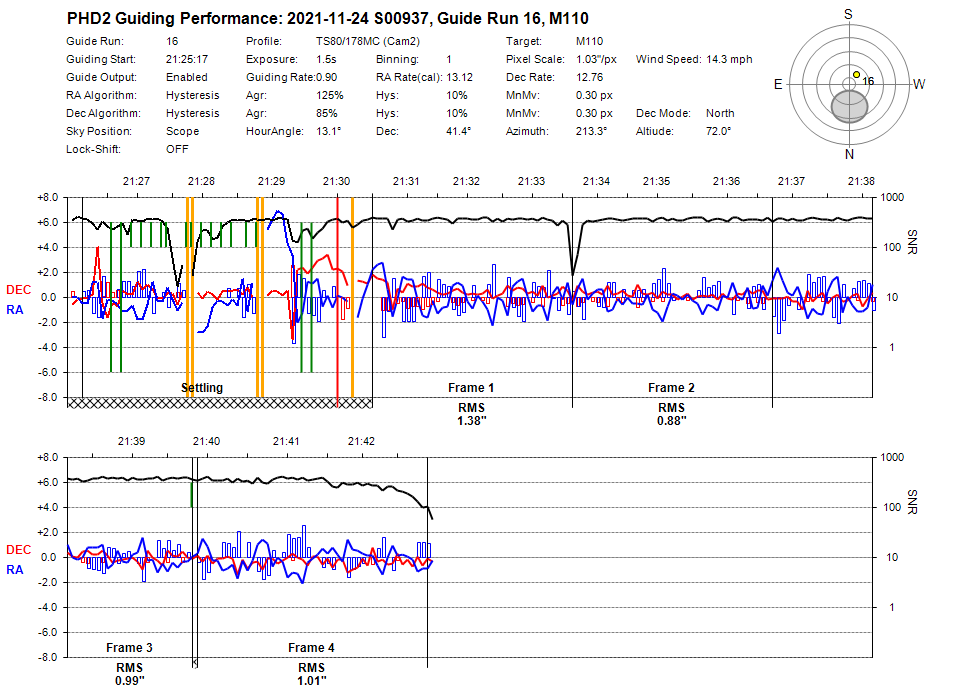
- AstroMain 3.37.3 installed just before Guide Run 16
- North Guide
Mode auto-selected at start which is currently the appropriate choice
for West of Meridian.
- Some Dec Spike at 21:26 to 21:30
(probably due to wind / cloud ? , several lost star events)
-
Generally good guiding 21:31 to 21:43
- Percentage <1" Total
Error : 57% ( <1" Ra Error: 68%, <1" Dec Error:
91%)
Actions
![]() Default Guide Mode. Following apparent overadjustment to Polar
Alignment in the preceeding S936 session the default guiding directions
used for telescope positions either side of the Meridian need to be
swapped over
Default Guide Mode. Following apparent overadjustment to Polar
Alignment in the preceeding S936 session the default guiding directions
used for telescope positions either side of the Meridian need to be
swapped over
(Done 2021-11-24, AstroMain 3.37.3)
![]() Excessive Anti-Backlash Compensation ?. Examine cases where
there is evidence of excessive antibacklash compensation with
indications that the Dec backlash in one direction is different to the
backlash in the opposite direction.
Excessive Anti-Backlash Compensation ?. Examine cases where
there is evidence of excessive antibacklash compensation with
indications that the Dec backlash in one direction is different to the
backlash in the opposite direction.
(Done
2021-11-26, See
Investigation - Excessive Backlash Compensation (2021-11-26) )
![]() Dec Guide Mode Changes. If change in Dec Guide Mode is
called for then its best to change during Settling/Focusing Stage rather
than wait to the end of focusing which places the chnage immediately
before the start of imaging. Also need to react quickly with a
second Guide Mode change if there has been a clear overreaction of
anti-backlash compensation.
Dec Guide Mode Changes. If change in Dec Guide Mode is
called for then its best to change during Settling/Focusing Stage rather
than wait to the end of focusing which places the chnage immediately
before the start of imaging. Also need to react quickly with a
second Guide Mode change if there has been a clear overreaction of
anti-backlash compensation.
(To do 2021-11-24, AstroMain 3.37.3)
Update 2021-12-08 .
Reducing the amount
of Dec backlash compensation by the scope hinders the ability to
correctly centre the telescope on target coordinates.
Based on
the guiding experience from recent sessions it would seem preferrable
that the number of Dec Guide Mode changes is minimised as the outcome of
a reversal in Dec Guiding direction is unpredictable. When
the guide star is clearly on the 'wrong' side of the N/S zero error line
(for the 'best/expected' guide mode) , than rather than changing the Dec
Guide Mode to bring the star back to zero error (and then change the Dec
Guide Mode again to correct star drift) it may be more prudent to simply
change the lock position during either the initial settling/focusing
phase or during a pause between frames, that resets the guide error at
0.
Back to Top
Issue: The scope sometime produces excessive (8-18")
movements in Dec.
At first sight looks like excessive backlash
compensation, but retrograde Dec motion may also be involved
Whilst
the normal advice is to turn off anti-backlash compensation in the scope and use
PHD2's own software controlled anti-backlash compensation the amount of Dec
backlash displayed by the observatory's LX200 scope is large (and variable)
ranging from 2700 to 4000ms (at guide rate of x0.90 sidereal) and unidirectional
Dec guiding has to be used. The Scope's (Anti) Backlash compensation
is used to quickly compensate for any necessary backlash when making initial
selection of Dec Guide Mode where it involves a change from scope's last
direction of dec movement. PHD2's own Backlash Compensation is disabled
for guiding runs.
Description : The issue was first noticed in session
S932 (2021-11-09). See
LX200
- Dec Guide Anomalies (SSE Sky) and is illustrated by the
example below. In this case there is apparent overreaction by
the scope's anti-backlash system f which has moved the scope's Dec position
from +3" to -5". Early time (first 10s or so) guiding isn't plotted, but
logs reveal that there was a similar excessive anti-backlash movement in the
first few seconds of guiding but in the opposite direction to the later
event.
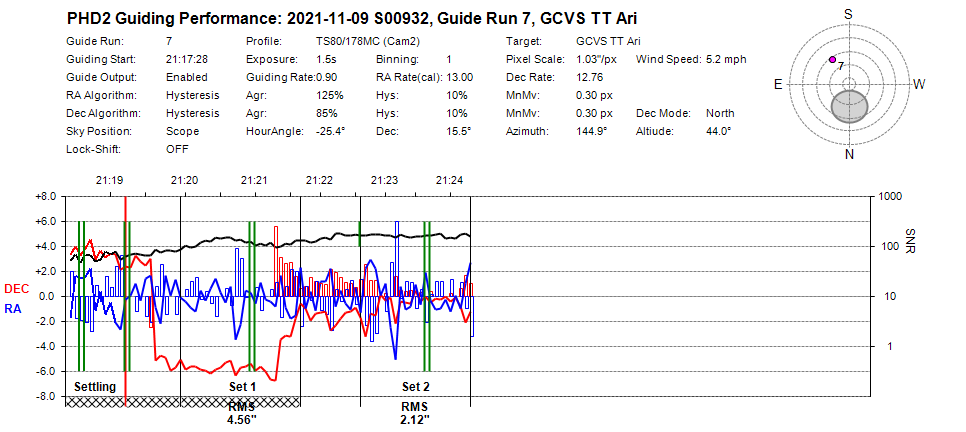
There have been a number of cases since then and they typically occur
when the scope is pointing to SSE region of the sky.
In the following
example from the S937 session there is a dramatic jump in Dec position when
the Dec Guide Mode is changed to South following a single 'small' (3" x 85%)
guide pulse. Dec error curve has exceeded the graph range, but logs
reveal that Dec position changed from +3" to -18". The small
guide pulse (reversing the last dec movement made to scope during centering)
is assumed to have triggered the scope's Backlash Compensation (Dec
Drive recently Trained and Anti-Backlash set at 100%). When
the Dec Mode is changed to North following Frame 1, the Backlash
Compensation for the reverse Gear movement is evidently not excessive and
several large guide pulses are still required to return the guide star to
its lock position (The issue may or may not have been exposed here because
the wrong Dec Guide Mode was initially selected)

Analysis
Guide Run 8 (132P/Helin-Roman-Alu) :
When Dec
Guide Mode was changed to South the Excess Motion was 18.5"
corresponding to 1360 ms (at x0.90 guide rate).
When Dec Guide Mode was
changed to North 27.4" of Dec Guiding was required to correct
the position, corresponding to 2020 ms (at x0.90 guide rate).
This suggests a 3380ms difference in backlash depending on the direction of
movement reversal. This is an almost impossible to handle.
A lower anti-backlash setting that prevents excessive compensation in one
direction would lead to guiding taking an inordinately long time to correct
movements.
Before Dec Drive was 'retrained' the antibacklash
setting was reduced from 130% to 80% to 20% but this failed to show a
demonstratable reduction in excessive compensation. This led to the decision
to retrain the RA/Dec drives (See
Ra/Dec Drive Training (2021-11-22) ) and the underlying
backlash was remeasured using PHD2 Guiding Assistent. See
Dec Backlash Measurements (2021-11-21) and
Residual Dec Backlash Measurements (2021-11-23).
With
scope pointing at Az/Alt position of earlier TT Ari guide run, Guiding
Assistent was unable to demonstrate lower Dec Backlash in this region of the
sky, and could not explain why the backlash compensation would have been
excessive for these SSE locations. It should be noted that Guiding
Assistent only measures the Backlash when changing from North Guiding to
South Guiding - it never measures the backlash when changing from South
Guiding to North Guiding.
Examining Guide Run 8 case in more detail
:
- Scope moving northwards during first part of slew to Target
(last part of slew saw the scope moving in RA only, but it might have
flicked south in final stage)
- Locate 1, Pointing Error -1.76'
N, 1.76' North Jog commanded, scope moved 2.41'
North in response !
(excess motion equivalent to 2880ms at x0.90
guide rate)
- Locate 2, Pointing Error +0.65' N, 0.65'
South Jog commanded, scope moved 0.12' North in response !
(retrograde motion equivalent to 530 to 3410ms at x0.90 guide rate)
-
Locate 3, Pointing Error +0.77' N, 0.77' South Jog commanded,
scope moved 0.76' North in response !
(retrograde motion
equivalent to 3360 to 6780ms at x0.90 guide rate)
- Locate 4,
Pointing Error +1.53' N, 1.53' South Jog commanded, little
or no scope movement in response !
- Star Drifted South 3",
2.55" South Guide commanded, Scope Moves south by 21" (0.35')
- Frame 1 taken. Star at 186.3 px
- North Guides commanded,
equivalent to a 17" movement (0.28')
- Frame 2 taken. Star at
172.9 px, equivalent to a 18.8" (0.31') movement to North since Frame
1
Prior to commanding 2.55" South Guide the scope had undergone 3
successive commands to Jog South so there seems to be no reason for the
scope to have applied backlash compensation at this point - unless the scope
was keeping track of actual scope movement (which was to north even though
commands were to move south, in which case the scope might have felt there
was a reversal of direction and applied backlash compensation.
Prehaps the 'excessive' motion to the south was represented release of
stored energy from the 3 failed attempts to jog the scope south (a total
South jog of 2.95' which resulted in a motion of around 0.9' north).
Retrograde Dec Motion ?
This behaviour may not be
due to excessive backlash compensation and might represent some form of
Retrograde Dec Motion. This is something that LX200GPS scopes
sometimes show. It's unlikely that this relates to a sudden
deterioration of scope's Dec bearing, but may relate in some way to the
recent installation of a New Dec Motor Unit (see
New Dec Motor Unit (2021-10-12) ). Prehaps the motor
isn't seated correctly with respect to the main Dec Gear. This
seems unlikely since the Drive sounds perfectly ok / smooth when slewing
(certainly better than the old Dec Motor Unit).
A couple of
charts from backlash tests using PHD2 on 2021-11-21 seemm to show
indications of retrograde motion, where at certain telescope positions the
scope seems to move north after changing over to 'South' guiding :

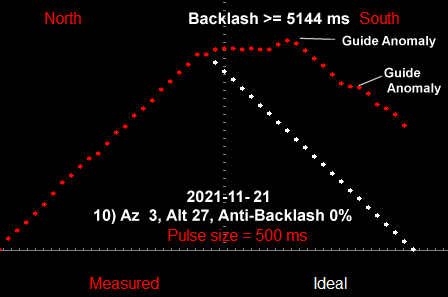
Useful Links:
Doc G Dec Axis Notes :
http://www.skymtn.com/mapug-astronomy/MAPUG/DecAxis.htm
Repairing the most common problems on the LX200 Dec/RA drive.
http://www.skymtn.com/mapug-astronomy/ccdastro/decfix.htm
From DocG Dec Drive Notes from MAPUG http://www.skymtn.com/mapug-astronomy/ragreiner/lx200repair.html :
"..The instructions indicate that some (back)lash is to be expected
when changing direction; doing North to South reversals. The manual says
that values of 2 to 4 seconds are normal. Since the
declination drive speed in normal guiding mode is 15 arc seconds per second
of time, one can correct for the delay by entering a number into the
computer to correct for the (back)lash. Nominally, the number entered is 15
times the number of seconds of delay. This number is entered once and need
not be changed. The number entered clearly corresponds to the number of arc
seconds of mechanical lash in the declination drive. Technically the lash
should be entirely in the gear reduction train and should be quite
symmetrical. Since the maximum lash that can be corrected is 99 arc seconds,
the actual delay time must be less than 6.6 seconds.
Many users have
found this (backlash) correction does not always work.
Often, users have found much larger delays and delays that depend
upon the position of the declination axis, the direction of the reversal,
the loading on the telescope and many other elements. Hysteresis,
dead zones, of up to 15 seconds have been reported .... If
the delay were in the motor/reduction gear train as expected, it should not
vary much since the "winding up" of the gear train is similar in either
direction. Loading effects on the declination axis are not strongly
reflected back into the gear train because of the almost unidirectional
transfer of forces through the worm gear. Typically it is not possible, with
a low pitch worm gear, which this is, to turn the worm at all with any
amount of torque on the main gear. Breaking of the gear would likely take
place first. However, loading of the main gear, as by unbalance of the
optical tube will greatly increase friction between the main gear and the
worm. Thus with an unbalanced optical tube, considerably greater drive force
through the reduction gearing is necessary.
The 146 mm diameter
declination gear should provide good pointing accuracy (but) it might be
noted that the same size drive is used on the 8", 10" and 12" LX200s. So
while the gear is adequate for the two smaller telescopes it (the
large Dec Gear) is somewhat marginal for the 12".
Many
users have discovered that end play in the worm gear mounting contributes to
the reversal delay. This is certainly an important effect. With the given
characteristics of the gears, a quick calculation shows that 1 arc second of
motion of the telescope tube corresponds to only 0.355E-3 mm of axial motion
of the worm. This is a required tolerance that is incredibly tight. Thus end
play in the worm drive must be eliminated as completely as possible. The
worm must be "snug" in its bearings and the entire drive platform
must be snug in its pivot mount. Adjustments are provided for in
the Meade mount via an end screw on the worm shaft bearing and a screw on
the platform mount bearing that can be adjusted. Both should be tightened
enough to eliminate all possible end play.
There is however another
source of play between the worm and the main gear. This is the radial motion
of the worm with respect to the main gear. For some reason, the worm in this
design is on a "floating" platform which allows for motion of the worm
radial to the axis of the declination drive. It is hard to understand why
this "floating" action is as large as it is. No other, of about a dozen
worm/gear drives I have inspected, has an action that allows for the large
motion that this one does. If one carefully measures the "float" action one
finds that the worm can move as much as 0.5 mm radially. The amount
of (floating) motion depends upon the direction of reversal and also on the
accuracy of balance of the telescope about the declination axis. If
the full "float" motion of the bearing platform is allowed,
it results in 0.08 mm motion of the main gear edge which is 220 arc
seconds of motion of the telescope tube. This is a motion ratio for
the worm to main gear surface of 7:1 which seems a bit large for this type
of drive.
The forces upon the worm that push it partly out of
engagement with the main gear are caused by the friction in the
declination bearings plus the forces due to unbalance of the telescope tube.
This seems to be one source of the varying delay in reversal operations. It
is also the source of retrograde motion. After evaluating numerous
operations of the drive with different unbalance loads, it became clear that
the amount of "float" is large, irregular and not necessarily repeatable.
Motion of the bearing platform was measured with a precision dial indicator
and varied from 0.025 mm with the tube well balanced to the full 0.5 mm with
a substantial unbalance. In terms of tube motion this amounts to
about 11 arc seconds .
There is also a time factor
involved with the resettling of the "floating" platform to its new stable
position. In addition, the platform takes on a different position
when the tube is being driven compared to what it takes when it is allowed
to rest. This settling of the platform position after ending a
motion cycle causes the tube to drift of the order of 2 to 20 arc seconds.
The drive mechanism seems to sort of relax after being exercised
The computer based correction scheme would work with constant
mechanical relaxation, it (the correction scheme) does not
work well when the relaxation is variable and erratic. As
well as being dependent upon the reversal direction, the
"float" and relaxation motion was much smaller for a telescope tube that is
perfectly balanced about the declination axis because then
only the friction forces and acceleration forces must be overcome.
There is a small spring under the floating bearing platform that presses the
worm against the main gear. If this spring is strong enough, it can keep the
worm pressed properly against the main gear as long as the unbalance is
small and the forces required to move the telescope tube are small.
As the unbalance gets larger, the spring no longer maintains
good contact between the worm and the main gear. The
concept that the telescope tube should be kept unbalanced to keep the drive
wound up in one direction is not valid in the case of the worm design.
Unbalance only increases friction in the drive and requires greater drive
force. Adding unbalance generally will not help nor work consistently even
if the end play and pivot play have been "tweaked" out.
Unfortunately
making the spring much stronger than the original
causes the force and thus friction between the
worm and the main gear to become too large and the drive
binds.
Why is the worm on a "floating" platform at all. One reason would be to keep the worm, on its floating platform and via a spring, to be held in optimum contact with the main gear. Another would be to allow for slight run out of the main gear.... In the case of the gear measured the run out was 0.1 mm. If main gear tolerances are typically 0.1 mm, there seems to be no reason for a "float" of 0.5 mm. In fact, there is an adjustable stop on the floating platform that limits the disengagement of the worm to the 0.5 mm observed. It seems that this adjustment could be tightened up to limit the "float" to be not more than required for the main gear run out. Reduction of the allowed worm platform motion was tried and does reduce the looseness of the drive linkage and the maximum slack allowed. To do this, the motion limiting screw needs to be raised toward the bottom of the platform. It was possible to tighten this tolerance until only 0.03 "float" remained on one drive and 0.05 on the other. This caused significant improvement in the total slackness within the drive systems. The retrograde motion was reduced but not eliminated.
.. another strange motion of the declination pointing mechanism was
observed. When the motion was reversed in either direction
a small retrograde motion remained. This was finally
traced to the mounting between the bearing platform plate and
the gear train housing on which the motor is mounted.
Unbelievably, the entire drive train/motor housing is attached to the worm
bearing housing with four small bolts and a thick rubber ring or gasket
(actually a small "O" ring.) Thus the whole reduction gear train housing can
move with respect to the worm bearing and when it does it allows the worm to
rotate with it. The amount of motion on one drive was 0.5 degrees rotation
of the worm. On the other it was 0.2 degrees. This
corresponds to an angular motion of the telescope tube of 10 or 4 arc
seconds. Before the motor drive train can
move the worm any amount, the rubber gasket must go from clockwise to
counter clockwise compression limits. (or vice versa for a
change in the opposite direction.) This working of the rubber gasket is
undoubtedly complex and may cause jerky motion of the worm often observed
during reversals. First retrograde and then correct motion is sometimes
observed. It is not at all clear exactly why this strange phenomenon takes
place. It was however, observed to be repeatable over many reversal cycles.
It must be related to the use of a rubber coupling element in the drive
chain. It is a weird hysteresis phenomenon which would not take place in a
linear system.
It is very tricky to get at the rubber "O" ring. The
entire gear drive assembly has to be dismantled. This operation is full of
traps and should not be attempted unless you are ready to replace a broken
motor/gear drive assembly in the case that you ruin it. The drive is
assembled from the inside out and at several points items are glued into
place and press fitted. It is exceedingly difficult to take apart....
Additionally, In both drive trains, it was found that the gear at the
end of the worm shaft was not tight. In one case 5 degrees and in the other
3 degrees of looseness was found. This accounts for most of the remaining
looseness and consequent hysteresis in the gear reduction system. ...
... when requesting reversal of declination motion, there is a total windup in the gears, worm and main gear of 45 arc seconds. This seems like a lot of windup in the gear train ... . The system as adjusted is now very tight mechanically, but still very smooth running. Since this wind up is symmetrical and consistent in amount, it can now be compensated for by the declination lash compensation. The compensation entered into the computer simply causes the drive motor to windup the required amount in the desired direction so that mechanical lash is absorbed and the forces applied are just enough to start motion of the declination axis.
In addition to tightening the looseness in the declination drive, it is useful to reduce forces due to unbalance and acceleration. The first is done by balancing the telescope tube carefully. The second can be reduced by reducing the slewing speed to less than 8, the default value. .. As a compromise, a setting of 4 might be used
Forward Plan
1) Reset Dec Motor Unit, and reduce
the free play in Dec Motor Tension Spring by adjusting the limit screw.
2) Rebalance the scope in Dec, going for either perfect balance (ideal)
or very slightly nose heavy.
Scope currently has issue
with moving south at low torque, and a tail heavy imbalance might be causing
this.
3) Try with Dec Anti-Backlash setting of 80% (instead of 90% /
100%), to a) reduce the probability of excessive movement occuring and b)
reduce the size of excessive movement if it still occurs.
4) Try
with PHD2 Backlash Compensation instead (even though Uni-Directional Guiding
is still the planned base method of guiding), turning off scopes'
Anti-Backlash compensation and compares results with 1).
Back to Top
Retrograde Motion
This describes a drive (usually
the Dec drive) that moves a bit in the opposite direction selected before
resuming in the correct direction. Autoguiders are confused by retrograde
motion. In effect, a small oscillation is set up as the autoguider program
attempts to correct for retrograde anomalies. Guider software has great
difficulty when this problem exists . This motion should not be confused
with backlash which is do to a normal mechanical problem with the gearing
system and which can be corrected with the backlash setting provided in the
LX200 software.
Notes from "Declination Drive Adjustments (without rebuild)"
(information supplied by Michael Hart, 13 May 1998, with editing and
commentary by Doc G)
http://www.skymtn.com/mapug-astronomy/ragreiner/decdriveadjust.html
The worm carriage spring tension can be adjusted to minimize
retrograde motion by REDUCING carriage spring tension just enough to lift
the worm into contact with the worm wheel and NO MORE. The purpose of the
carriage spring is to variably remove backlash in the Dec drive. A small
amount of carriage float is necessary to handle any eccentricity of the worm
gear. The amount of carriage float is adjusted by the carriage set screw
stop. If all of the float is removed with the carriage stop set screw, it is
likely the worm will bind against the worm wheel at some point. The idea is
to remove excessive carriage travel, but still allow for a bit of worm wheel
run out.
The carriage spring easily handles run out in the main gear
and in the facing between the inside Dec clutch plate and the 1" optical
tube shaft , but extra tension not needed causes retrograde motion. On
can selectively add or remove retrograde motion by increasing or decreasing
carriage spring force. If the Dec drive is excessively noisy or retrograde
motion is experienced, reduction of carriage spring force can help.
Note by Robert Preston
https://www.skymtn.com/mapug-astronomy/MAPUG/DecAxis.htm#anchor669042
... eliminated retrograde backlash completely simply by unscrewing
the motor assembly slightly (two allen-head screws) and then tightening it
down again, in almost the very same position it had before I loosened it. It
seems that the allowable slop in the mounting holes of the motor assembly
had allowed my motor assembly to be located in a position that caused
retrograde...
Back to Top
| This Web Page: | Notes - Session 937 (2021-11-24) |
| Last Updated : | 2024-03-23 |
| Site Owner : | David Richards |
| Home Page : | David's Astronomy Web Site |